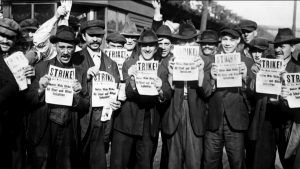A timber industry strike that echoes today
As millions of people take to the streets to protest racism and police violence, voices of the Right—both its fascist and corporate incarnations—cry out to blame a favorite bogeyman, the “outside agitator.”
Blame it on “outside agitators”
No one should be surprised. At nearly every point in American history, racists, bosses, politicians and media personalities have tried to label social justice rebellions as the work of a handful of “outside agitators”— troublemakers looking to import chaos to otherwise serene places. 
A list those labeled “outside agitators” in the twentieth century reads like a “who’s who” of social movements: much of the Civil Rights Movement (including MLK), the Wobblies, and the 1999 Seattle WTO protestors. “Outside agitators” this spring are in good company.
Depression in the Pacific NW lumber industry
The Evergreen State has its own history of using this label to suppress social movements. Readers might hear echoes of a powerful 1935 lumber strike in the media response to today’s uprisings.
Lumber was the largest and one of the most dangerous industries in the Pacific Northwest. Each day, loggers and mill laborers risked that a falling log, flying cable, or spinning saw might take their life. In his wonderful new book, Radical Seattle: The General Strike of 1919, historian Cal Winslow writes: “Conditions were dangerous in the hills and equally brutal in the mills. There, men and boys worked on and among giant saws, with their deafening noise in air that seemed more sawdust than nitrogen and oxygen.”
The Depression cut deep into the lumber industry, tossing thousands of people out of their jobs. In desperate times, workers had few institutional resources. Cities and charities failed to provide adequate relief. Most lumber workers’ unions had been squashed by a combination of state repression, vigilantism, and internal union dissension.
A new movement leads a fight for better conditions
In the early 1930s, a new movement arose, sparked by the grassroots activism of Communists, Wobblies, and other labor militants. In many Northwest cities, unions allied with community organizations to press politicians for relief, free milk for schoolchildren and pro-labor legislation
In the thick of the Great Depression, between 30,000 and 40,000 Pacific Northwest lumber workers struck. They demanded recognition of their industrial union, a 30-hour workweek and increased wages. In May 1935, unionists and their allies in Grays Harbor and across the Northwest took to the streets, parading and setting up picket lines no one was allowed to cross.
Blame “outside agitators” and invite repression
A violent response by the anti-unionist bosses, politicians, cops, and journalists portrayed rank-and-file strike activists as Communists and outside agitators. “Red Baiting was raised here in 1935 to such an extent that headlines appeared in London papers branding our Parades as Red Marches,” noted one union publication. A front-page article in the Seattle Post–Intelligencer wrote that Washington Governor Clarence D. Martin, a conservative Democrat, “served notice today on Communists and agitators that he will not tolerate coercion and intimidation.”
As we’ve seen in the recent uprisings, as soon as elites blame protests on “outside agitators,” armed agents of the state join vigilantes to brutalize, jail, even kill those working for change. In a statement that could have come from the twenty-first century, one conservative union leader blamed the spreading strike on a “flying squadron of Red” coming from Portland.
In 1935, lumber bosses had allies in city halls and the state capitals. To protect property, police rounded up picketers. Bosses recruited strikebreakers, both on the Harbor and in the wider Pacific Northwest. On May 14, a car driven by scabs ran through a picket line at the Aberdeen Plywood factory, seriously injuring one picketer. In July, a Hoquiam scab fired a shotgun into a picket line, wounding four men and a boy.
The state and National Guard move against the strikers
Governor Martin took an active role in breaking the strike. Using “right to work” rhetoric, he ordered the state patrol to “protect workers” in eastern Grays Harbor, where employers complained that “outsiders” were picketing and threatening scabs. On June 8, the state patrol went to Longview to break a blockade that prevented traffic from entering the Long-Bell and Weyerhaeuser mills. To justify his use of state forces, Martin red- baited the strikers:
Investigation has revealed such interference and threats come primarily from agitators, including some professional communists who are taking advantage of the situation to foment discontent and violence. These forces are determined to promote industrial trouble even to the extent of undermining our institutions and government. Now, as governor, I serve notice such communistic activities, professional agitation, coercion and intimidation must not be tolerated in Washington.
In late June, Martin sent the National Guard to Tacoma to forcibly reopen the mills. They set up a machine gun and attacked picketing workers with tear gas. Brigadier General Carlos A. Pennington of the Guard banned picketing in Tacoma. The troops made a spate of arrests, interning strikers at the local Armory.
A couple of weeks later, the National Guard teargassed 400 picketers at the Bay City Lumber Company in Aberdeen, the same mill where, 12 years earlier, a company gunman murdered a Wobbly striker.
The violence made a lasting imprint on local workers. Aberdeen unionist Mickey Orton’s description of the 1935 attacks could have been written this spring:
State Highway Patrol and the State Militia were placed at the disposal of the operators and local law enforcement agencies… by the definitely hostile anti-labor state administration of Washington and Oregon. Practically in every instance where the State Highway Patrol and the National Guard were brought into the picture, violence became rampant. Peaceful, striking workers were gassed, beaten, maimed, and injured.
Vigilantes join in the violence
Vigilantes joined police to crush the strike. On July 1, they dynamited the home of Frank L. Morgan, president of the Grays Harbor Bar Association who was due in court the next day to defend a striker. The blast tore through the first floor but did not harm Morgan or his two daughters who slept inside. Earlier, in Eureka, California, gunmen had shot and killed two striking lumber unionists, as well as a third man unlucky enough to be in the way of an anti-unionist bullet.
Significant gains won by timber workers
At the end of four months, lumber workers returned to work, having carried out one of the Pacific Northwest’s largest strikes, a massive, industry-wide conflict that crippled the largest industry in the region—and brought significant gains for timber workers and their families. Among other gains were higher wages, shorter hours, and better working conditions.
The strike also led to a ballooning of the region’s timber unions, which by the end of 1935 counted 35,000 thousand members with thousands more joining each month.
A greater sense of hope and solidarity likewise came with the strike. Lumber workers had a better idea of what they could accomplish when joined in common cause. A year after the strike ended, the region’s lumber workers formed the Federation of Woodworkers (FOW), with an estimated 100,000 members, making it the largest labor union on the Pacific Coast.
Those in power will fight movements by inciting violence against “others”
Northwest employers never stopped blaming outsiders in their efforts to divide and conquer the labor movement. A few years after the strike, the Business Builders, a far-right organization, claimed outsiders were responsible for labor troubles: “That the loyal citizens of Grays Harbor settle their own problems, rather than permit outsiders to come in whose only desire is to establish conditions which can be used as examples for other districts.”
Call out the “outside agitator” narrative
Today’s global demonstrations against police violence and a lumber strike 85 years ago aren’t the same. But in both cases, those in power fought movements demanding humane treatment for the oppressed by “othering” the protestors and inciting police violence and vigilantism against them. Bosses, politicians, and militarized police forces will always wage class war from above. Elites know what they’re doing when they employ dishonest “outside agitator” rhetoric.
The 1935 Pacific Northwest Lumber Strike, like practically any grassroots uprising for social justice, is proof that when people take to the streets, those in power will rush to their podiums to announce and denounce the arrival of “outside agitators.”
I’ve seen folks on social media mocking politicians and bosses for rolling out this ol’ standby—the outside agitator— to sow dissent among protestors. Keep it up! Rejecting and calling out the dishonest “outside agitator” narrative is a step toward countering the power and propaganda of those seeking to quash dissent.
Aaron Goings is a historian based in Tacoma. His book, The Port of Missing Men: Billy Gohl, Labor, and Brutal Times in the Pacific Northwest will be published by the UW Press this summer.

Be First to Comment